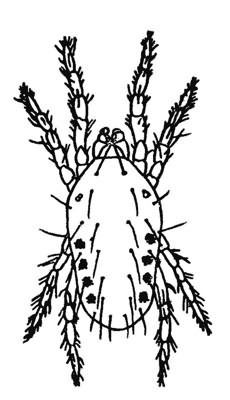Pests
Eotetranychus pruni (Oudemans) - Garden Spider Mite
Systematic position.
Class Arachnida, order Prostigmata, superfamily Tetranychoidea, family Tetranychidae, genus Eotetranychus Oudemans.Synonyms.
Apotetranychus Oudemans; Schizotetranychus viticola Reck, Sch. aceri Reck, Sch. aesculi Reck, Sch. ulmicola Reck, Sch. coryli Reck, Sch. telarius kargalensis Wainstein, Eot. pomi Sepasgosarian.Biological group.
Pest of vine, apple, pears, plums, cherry-plum and apricot.Morphology and biology.
Female body length 0.42 mm, width 0.24 mm. Piercing and suctorial type of mouthparts. Cheliceral base oviform, pedipalp clava 2.5-4 times longer than wide. Apical part of peritreme is unramified, curved back, consisting of 2-3 chambers. Foreleg empodium with 3 pairs of needles. Foreleg tarsus bearing 19 setae, 2nd pair of legs with 16 setae, hind two pairs of legs with 11 each. The body dorsal chaetotaxy consisting of 26 setae arranged in 7 transversal rows; all the setae located in excavations of the skin. The setae are long, their apex reaches the base of setae of the next row. Male body length 0.25-0.3 mm. Foreleg tarsus bears 20 setae, chaetotaxy of the rest tarsi is the same as that in female. Penis is long, without hook, with variable shape. E. pruni has typical arrhenotoky type of parthenogenesis. Life cycle of mites includes stages of egg, larva, protonymph, deutonymph, and adult. Transition between postembryonal stages occurs through phases of dormant and moult. Larva with 3 pairs of legs. Body length 0.18 mm in larva, 0.23 mm in protonymph, 0.31 mm in deutonymph.Distribution.
Western Europe, Northern Africa, Iran, Northern America. In the former USSR it inhabits the European part northward to Moscow and Leningrad Regions, the South of the Far East, Armenia, Georgia, Azerbaijan, Middle Asia, and most part of Kazakhstan.Ecology.
The temperature threshold of development is about 12°C (or 10.2°C after some of publications). The degree days sum for a generation development is 170°. The generation lasts 15-40 days. The species gives 8-9 generations in Armenia and Azerbaijan, 6-9 in Kazakhstan, 12 in Tadjikistan. Impregnated females only hibernate, having orange-yellow color. They are located under bark, inside cracks, under leaves, or in grass, at a distance 25 cm and less from the host plant stem. A few hundred thousands specimens are sometimes concentrated in overwintering colonies. During hibernation, the females survive short period of freezing to -20°C. The largest part (about 70%) of population is usually consumed in frozen winter; individuals survive only under the blanket of snow. In spring, adults appear just before or concurrently with bud blossoming. In Transcaucasia, mites appear on green parts of vine in the 1st half of April; mass migration to leaves occurs in the 2nd half of the month. First they occupy leaves of the lower layer, then go higher. In females, body color changes into greenish in a few days after feeding start and oviposition begins soon. Mass oviposition occurs in the 1st half of May. Fertility is about 30-100 eggs. Egg is globular, 0.11 mm in diameter; first it is transparent, then muddy-yellowish. The female lays eggs covered with cobweb along ribs on the underside of leaves. The air temperature about 22-25°C and humidity 60-70% are the most favorable conditions for the mites. Low air moisture is a limiting factor. Mass propagation of the mites occurs in July-August. Yellow females, which are ready for hibernation, appear in autumn. All larvae, nymphs, and propagating females perish after frosts begin. Population density in nature depends on the activity of predators; e.g.: Typhlodromus reticulates Oud., Phytoseius spoofi Oud., Scolothrips acariphagus Sakh., Scymnus (Stethorus) punctillum W.S., and larvae of Chrysopa carnea Steph.Economic significance.
Chlorophyll is destroyed in infested leaves, and some of the leaves fall off. Damaged leaves become yellowish on white varieties of the vine and reddish-brown on black varieties. E. pruni damage causes the loss of grape yield by 15-60% and decreases of sugar content in grapes. The yield of apples sometimes decreases 3 times in Tadjikistan. It has been found that vine varieties with denser leaf pubescence are more resistant. Therefore, the cultivation of resistant varieties is an important preventive control measure against the pest. Control measures include also treatments by systemic acaricides at the pest mass abundance.Reference citations:
Bagdasaryan A.T. 1957. Fauna of the Armenian SSR. Tetranychid mites (Superfamily Tetranychoidea). Erevan: AN Armenian SSR. 163 p. (in Russian).Beglyarov G.A. & Mitrofanov V.I. 1970. On species status of the Schizotetranychus viticola Reck. In: Markevich A.P., ed. 2nd Conference of Acarology. Abstracts. Part 1. Kiev: Naukova Dumka, p. 56-57 (in Russian).
Livshits I.Z., 1967. Morphological and biological peculiaritis of Panonychus ulmi Koch, 1836 and Schizotetranychus pruni Oudemans, 1931. In: Kochkin M.A., ed. Pests and diseases of fruiters and ornamental plants. Proceedings of the Nikitskii bot. garden. Vol. 39. Yalta: Nikitskii bot. sad, p. 73-110 (in Russian).
Livshits I.Z. & Mitrofanov V.I. 1973. A contribution to the fauna and biology of tetranychid mites of the Crimea (Acariformes, Tetranychoidea). In: Proceedings of the 3rd international congess of the Acarology. Prague: Academia, p. 229-235 (in English).
Livshits I.Z. & Mitrofanov V.I. 1984. Order Acariformes. In: Kopaneva L.M., ed. Keys to harmful and useful insects and mites on fruit and berry crops in the USSR. Leningrad: Kolos. 288 p. (in Russian).
Mitrofanov V.I., Strunkova Z.I. & Livshits I.Z. 1987. Keys to the tetranychid mites (Tetranychidae, Bryobiidae) of the Fauna of the USSR and adjacent countries. Dushanbe: Donish: 224 p. (in Russian).
Reck G.F. 1959. Keys to tetranychid mites. Tbilisi: AN Georgian SSR, 151 p. (in Russian).
Reck G.F. 1976. Catalogue of the Acariformes of the Georgian SSR. Tbilisi: Metsniereba, 128 p. (in Russian).
Strunkova Z.I. 1966. Biology and ecology of the Schizotetranychus pruni Oud. (Acarina, Tetranychidae) in Tadjikistan. Izvestiya AN Tadzhikskoi SSR 1(22): 83-95 (in Russian).
Strunkova Z.I. 1966. Data to biology and ecology of the Schizotetranychus pruni Oud. (Acarina, Tetranychidae) in Tadjikistan. Izvestiya AN Tadzhikskoi SSR 3(24): 69-80 (in Russian).
Vainshtein B.A. 1960. Tetranychid mites of Kazakhstan. In: Dzhiembaev Zh.T., ed. Proceedings of NIIZR Kazakh AS. V.5. Alma-Ata: Kazakh. Gosizdat, 276 p. (in Russian).


